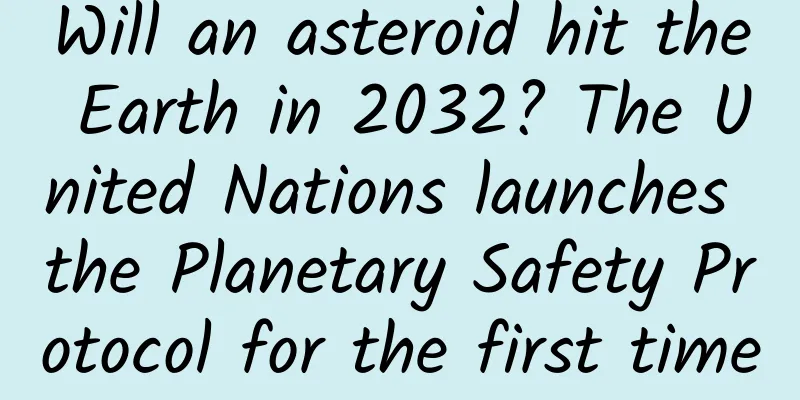Will an asteroid hit the Earth in 2032? The United Nations launches the Planetary Safety Protocol for the first time

|
According to a report on the website of El Spaniard on February 4, an asteroid named 2024 YR4 is expected to pose a risk of collision with the Earth within seven years. The United Nations has launched the Planetary Safety Protocol for the first time to deal with this threat. The impact corridor predicted by the National Space Science Center of the Chinese Academy of Sciences based on observation data on February 7 What is the origin of the asteroid 2024 YR4? Image of asteroid 2024 YR4 provided by NASA First sighting : On December 27, 2024, it was first reported by the University of Hawaii's Asteroid Last Alert System (ATLAS) station in Chile. Diameter : Probably 40-90 meters Impact probability : On February 7, 2025, the probability of the asteroid hitting the Earth has increased from 1.6% announced on February 5 to 2.3%, and is still changing dynamically. Estimated approach to Earth : December 22, 2032 TIPS What if the 2024 YR4 asteroid hits Earth? According to scientists' calculations, the airburst power of the 2024 YR4 asteroid hitting the Earth is equivalent to about 8 megatons of TNT , which may cause regional disasters and cause huge damage, but it is far from causing extinction. There have also been famous celestial body impact events in history: Tunguska Event Date: June 30, 1908 Location: Tunguska region, Siberia, Russia Impactor: Asteroid or comet fragment 50-70 meters in diameter Impact: The blast had an energy equivalent to 10-15 million tons of TNT and destroyed about 2,000 square kilometers of forest. Chelyabinsk incident Date: February 15, 2013 Location: Chelyabinsk Oblast, Russia Impactor: Asteroid about 20 meters in diameter Impact: The blast had an energy equivalent to 400,000 to 500,000 tons of TNT, injuring more than 1,500 people, mainly from broken glass. Image credit: Alex Alishevskikh/wikipedia What can humans do? 1. Continuous tracking and observation The International Asteroid Warning Network (IAWN) unites observatories and observation agencies around the world to use ground-based and space telescopes to continuously monitor near-Earth objects and detect potential threats in a timely manner. As a formal member of the IAWN, China organized multiple domestic telescopes to conduct joint observations and share observation data during the asteroid impact events in September and December 2024, contributing Chinese strength to the global response. With the increase in observation data and the improvement of monitoring technology, scientists can more accurately assess the orbits and impact risks of asteroids, and most asteroid warnings will eventually be lifted as more data is accumulated . For example, the 2023 DZ2 asteroid was briefly marked as "1/430 probability of hitting the Earth on March 27, 2026" in the early days of its discovery, but as more observation data accumulated, this probability was reduced to zero. 2. Change the orbit of asteroids Humans have been exploring ways to defend against near-Earth objects. The scientific methods currently proposed include: launching a probe to fly closely with the target asteroid and use gravity to drag it off its orbit; or intercepting it with a nuclear explosion and using a precisely calculated nuclear explosion shock wave to push the asteroid away, etc. eg. In 2022, NASA's Double Asteroid Redirection Test (DART) successfully deflected the orbit of the asteroid Dimorphos by crashing an extremely fast probe into the asteroid. Schematic diagram of the DART probe's impact with the asteroid Dimorphos. Source: NASA/Johns Hopkins APL It is precisely because of the continuous advancement of astronomical observation technology that human beings’ monitoring and early warning capabilities of near-Earth objects have gradually increased, making it possible to detect and assess potential impact threats in advance, and further promoting the formulation and implementation of long-term interstellar defense plans. Author & Editor: rain Thanks to: Li Yide from Shanghai Institute of Aerospace Systems Engineering; Shui Xiong from Shanghai Astronomical Museum References: El Spaniard, Xinhua Daily Telegraph, Institute of High Energy Physics, Chinese Academy of Sciences, Planetary Science, etc. |
<<: The Big Dipper is not actually seven stars? One of them is secretly "paired"?
>>: Why do I always want to stick my feet out of the quilt when I sleep?
Recommend
The latest regulations on the 2022 delayed retirement age policy: When will it be officially implemented?
In recent years, the issue of pension has receive...
Down jackets don't actually contain "down"? The police took action! One picture shows how to distinguish true from false
“No need for 998, no need for 198!” “Down jacket ...
Is your understanding of the “mixed” COVID-19 vaccine correct?
Xinhua News Agency, Beijing, February 21 (Reporte...
More than 90% of copywriting persuades consumers from these five dimensions
There are many ways to write copy with the ultima...
The whistleblower claims that Apple is still developing Touch ID under the iPhone screen
According to foreign media reports, according to ...
India's mobile phone manufacturing industry still faces problems: lack of skilled workers and incomplete supply chain
India’s dream of becoming a smartphone manufactur...
Qinghai school start time 2020 specific time: 2020 spring semester insists on online classes first, staggered start
In order to thoroughly implement General Secretar...
Soft article placement, using 600 yuan to achieve 20,000 yuan of effect
Soft article placement refers to the process of p...
The State Administration of Radio, Film and Television shot a blockbuster advertisement! ! !
Legend has it that there is such a mysterious org...
How to completely complete a Weibo event promotion?
As we all know, a good event operation can often ...
This "little superman" among animals can actually stack physical and chemical buffs when facing enemies
In nature, all kinds of animals have evolved diff...
When will the Shenzhen epidemic end in 2022? Why is it so serious? Attached is the latest standard for unblocking
Recently, there have been more than 300 confirmed...
New traffic diversion methods in 2020 and 6 implementation steps!
Behind every search action and every click is a l...
Army Day | China's aircraft carrier opens the "three-ship passenger" era, experts explain electromagnetic catapult and conventional power
Today is the Army Day. For 95 years, we have over...
How can major manufacturers prove their innocence when Android fingerprint unlocking is hacked?
Just look at your own phone to see how unsafe thi...









